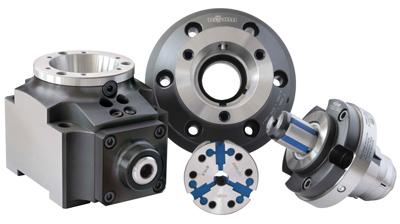
Röhm Products America has introduced the modular CAPTIS workpiece clamping system, which provides a range of workholding options for turning, milling and drilling applications through different combinations of modular components.
An innovative quick-change method permits conversion from external to internal clamping in less than a minute, and collet changes can be made in 15 seconds. It is compatible with the industry standard BZI collet interface. The CAPTIS system produces strong clamping forces without deformation of delicate workpieces while offering high repeatability and minimal runout.
Different configurations of the CAPTIS system deliver a variety of workholding functions:
• The power-operated, rotating CAPTIS collet chuck is designed for use in turning machines. Its compact size facilitates full use of a machine's work envelope.
• CAPTIS-D is equipped with axial tightening for machining bar stock and can be easily converted to the CAPTIS-A, which is ideal for flange-type workpieces and includes workpiece stop and hold-down features.
• CAPTIS-AF, with an axially fixed (dead-length) collet and optional workpiece stop, is reportedly ideally suited for delicate workpieces, short clamping surfaces and use in counter spindles.
• The stationary CAPTIS-MS collet chuck is intended for use in drilling, milling and machining centers and for manual machining. Operated manually with hydraulic power intensification, the chuck can be optionally equipped with a front or internal stop.
Contact Details
Related Glossary Terms
- centers
centers
Cone-shaped pins that support a workpiece by one or two ends during machining. The centers fit into holes drilled in the workpiece ends. Centers that turn with the workpiece are called “live” centers; those that do not are called “dead” centers.
- chuck
chuck
Workholding device that affixes to a mill, lathe or drill-press spindle. It holds a tool or workpiece by one end, allowing it to be rotated. May also be fitted to the machine table to hold a workpiece. Two or more adjustable jaws actually hold the tool or part. May be actuated manually, pneumatically, hydraulically or electrically. See collet.
- collet
collet
Flexible-sided device that secures a tool or workpiece. Similar in function to a chuck, but can accommodate only a narrow size range. Typically provides greater gripping force and precision than a chuck. See chuck.
- gang cutting ( milling)
gang cutting ( milling)
Machining with several cutters mounted on a single arbor, generally for simultaneous cutting.
- milling
milling
Machining operation in which metal or other material is removed by applying power to a rotating cutter. In vertical milling, the cutting tool is mounted vertically on the spindle. In horizontal milling, the cutting tool is mounted horizontally, either directly on the spindle or on an arbor. Horizontal milling is further broken down into conventional milling, where the cutter rotates opposite the direction of feed, or “up” into the workpiece; and climb milling, where the cutter rotates in the direction of feed, or “down” into the workpiece. Milling operations include plane or surface milling, endmilling, facemilling, angle milling, form milling and profiling.
- turning
turning
Workpiece is held in a chuck, mounted on a face plate or secured between centers and rotated while a cutting tool, normally a single-point tool, is fed into it along its periphery or across its end or face. Takes the form of straight turning (cutting along the periphery of the workpiece); taper turning (creating a taper); step turning (turning different-size diameters on the same work); chamfering (beveling an edge or shoulder); facing (cutting on an end); turning threads (usually external but can be internal); roughing (high-volume metal removal); and finishing (final light cuts). Performed on lathes, turning centers, chucking machines, automatic screw machines and similar machines.
- work envelope
work envelope
Cube, sphere, cylinder or other physical space within which the cutting tool is capable of reaching.
